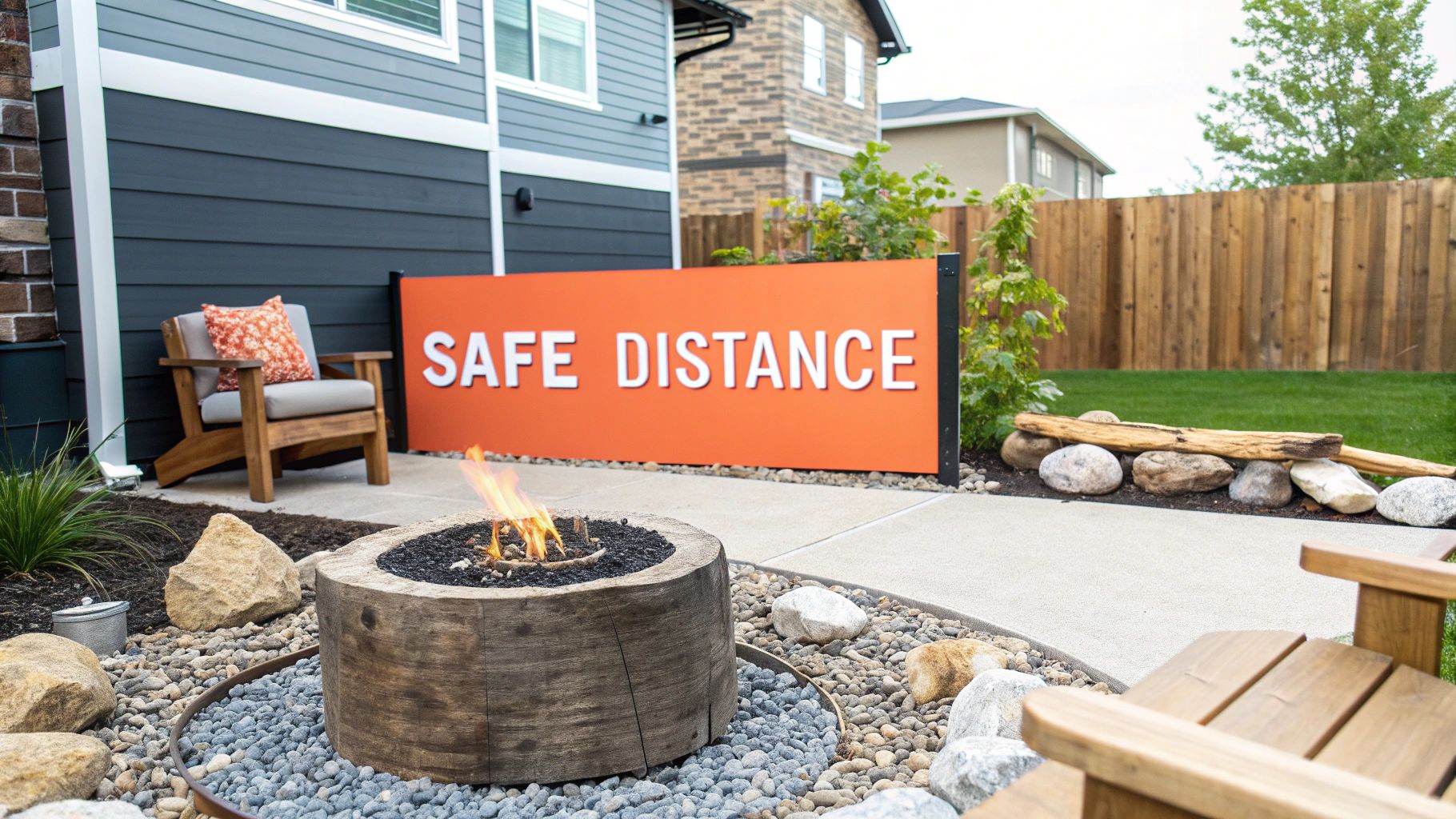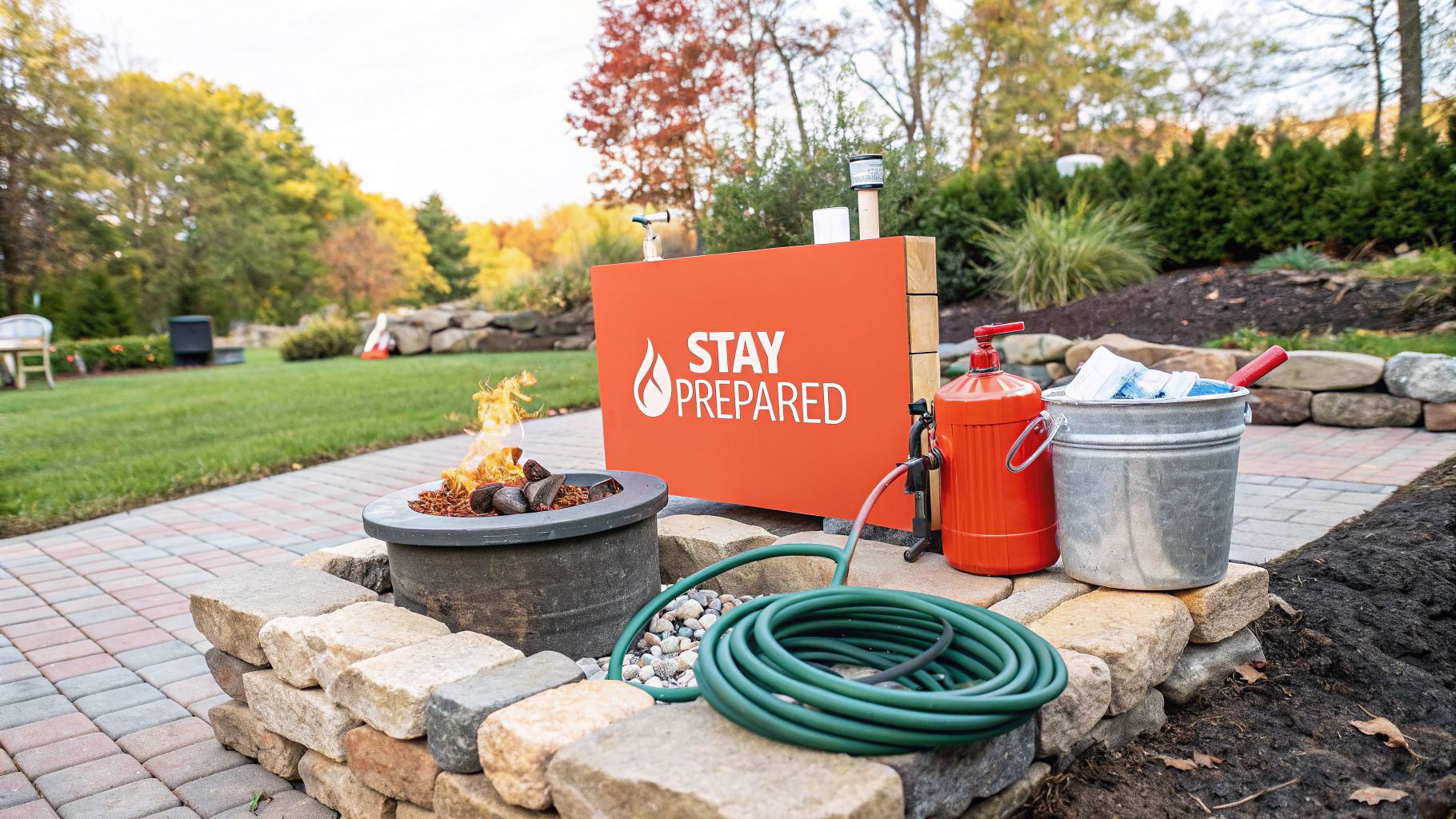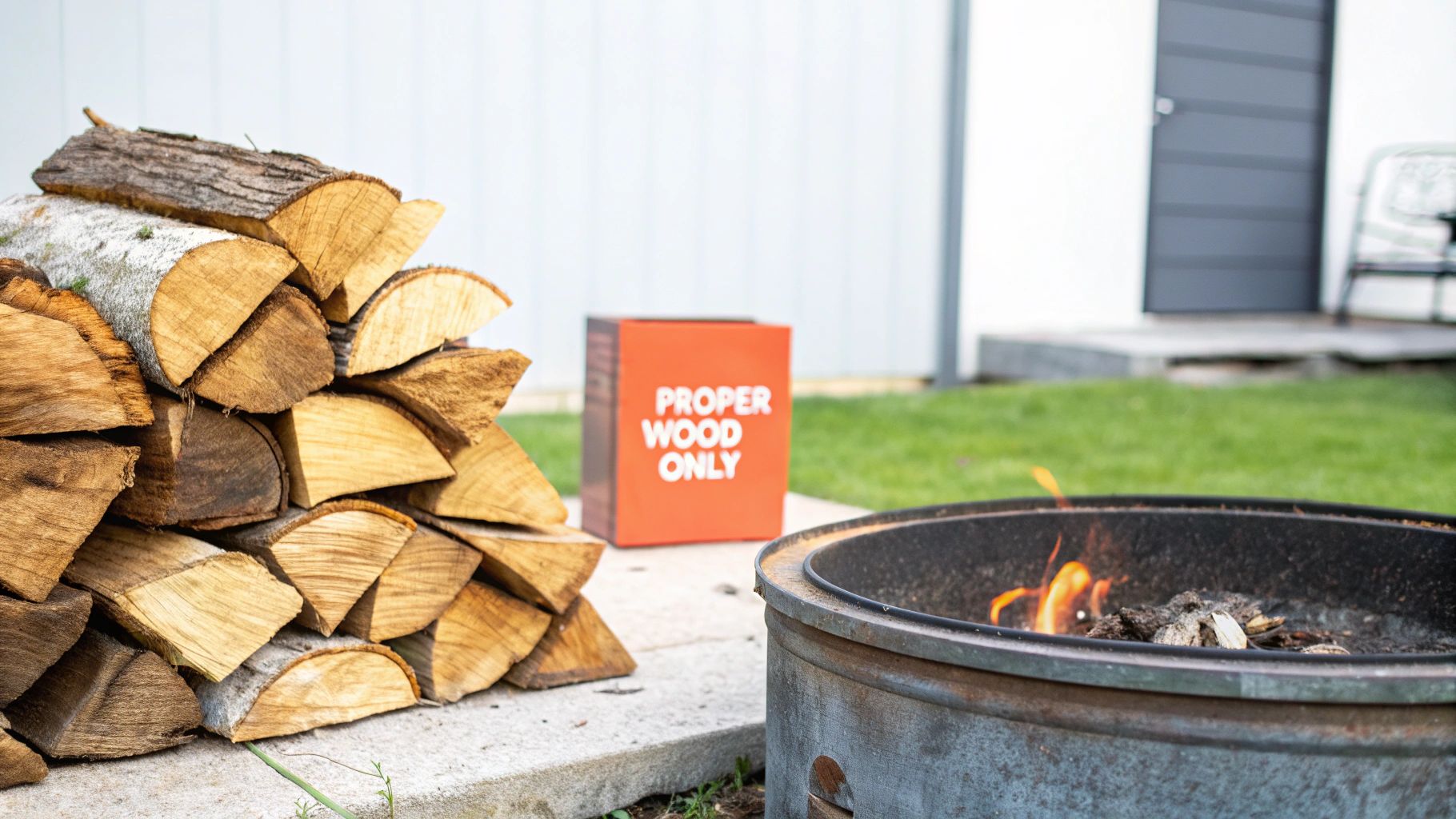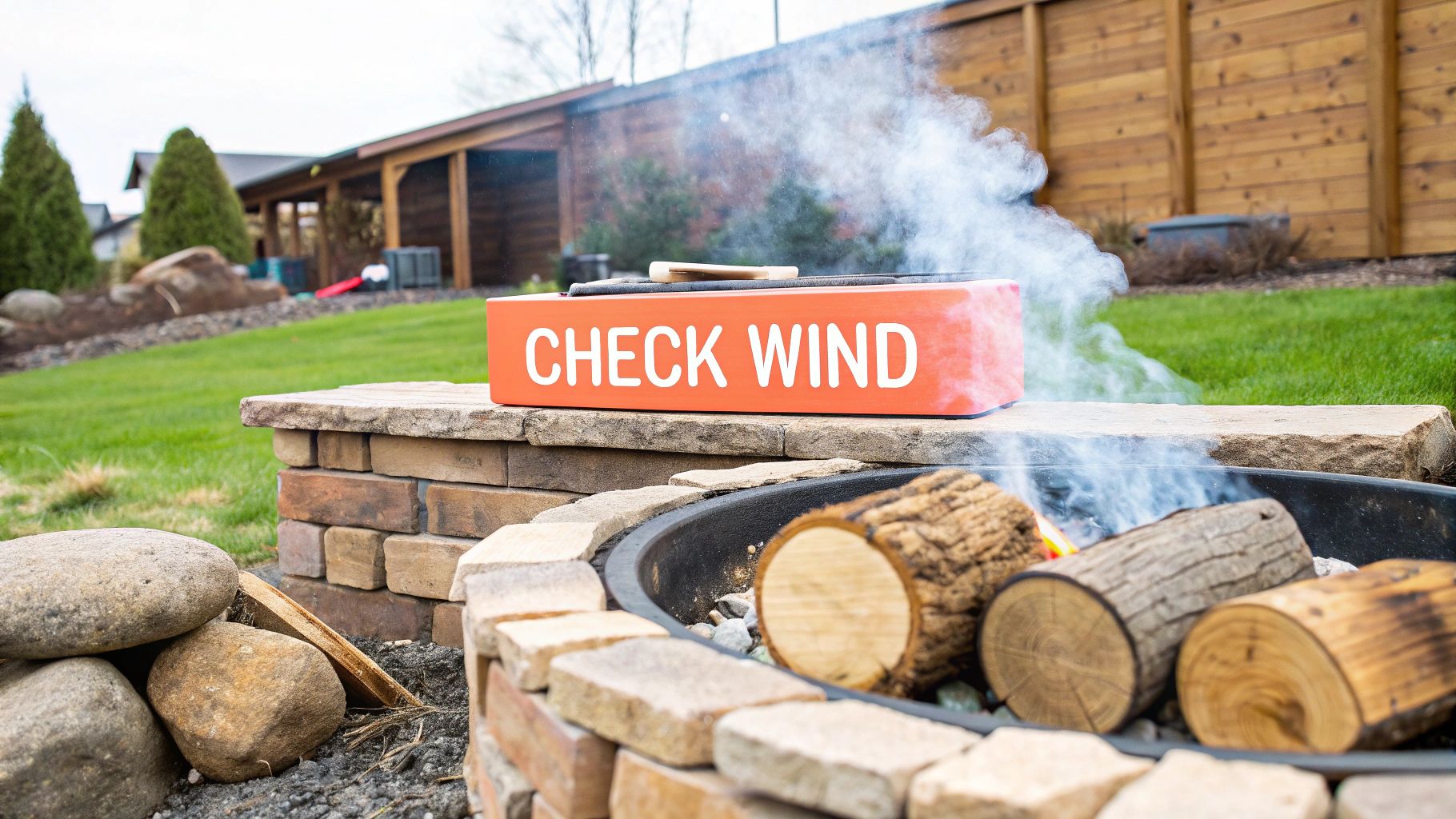-
CALL US:
- (866) 952-3456
A fire pit transforms any backyard into a cozy gathering spot, perfect for storytelling and marshmallow roasting. But with the allure of open flames comes a critical responsibility for safety. Moving beyond common sense, this comprehensive guide provides a detailed look at essential fire pit safety tips that every homeowner must master. From selecting the right location to understanding fuel and weather, these actionable strategies ensure your warm evenings remain memorable for all the right reasons.
We will explore the nuanced details of proper installation, emergency preparedness, and responsible operation, giving you the confidence to enjoy your fire feature safely and without incident. This isn't just a list of warnings; it's a practical roadmap to preventing accidents before they happen. You'll learn not just what to do, but why it matters, with specific advice on everything from creating a non-combustible zone around your pit to having the right extinguishing tools within arm's reach. For those new to fire pits or seeking absolute peace of mind, professional setup can provide a crucial foundation for safety, ensuring your unit is installed correctly from day one. Let's ignite your evenings safely.
One of the most critical fire pit safety tips is establishing and maintaining a safe distance from your home and any other combustible materials. An open flame, no matter how contained, requires a significant buffer zone to prevent radiant heat or stray embers from igniting nearby objects. This foundational step is non-negotiable for preventing property damage and ensuring the well-being of your family and guests.

The National Fire Protection Association (NFPA) and International Fire Code (IFC) generally recommend a minimum clearance of 10 to 20 feet in all directions. This includes your house, shed, deck, fences, and even low-hanging tree branches. For broader considerations on the safe planning of outdoor entertainment areas, ensure your fire pit is positioned with ample clearance from the very beginning of your design process.
A safe clearance zone, often called a "defensible space," serves multiple purposes. It prevents radiant heat from melting vinyl siding or damaging wooden structures over time. More importantly, it creates a barrier that stops wind-blown sparks and embers from reaching flammable materials like dry leaves, patio furniture cushions, or a woodpile. Ignoring these distances is a leading cause of accidental fires originating from backyard recreational burning. This is also a key component of a larger childproofing strategy for your yard; for more information, you can learn about creating a secure outdoor environment for children on Assembly Smart.
Before you ever light your first fire, take these precise steps to secure your space:
Beyond creating a safe perimeter, one of the most vital fire pit safety tips is ensuring you have immediate access to fire suppression tools. A small flare-up or a stray ember can escalate into a dangerous situation in seconds. Having a reliable method to extinguish the fire quickly is a non-negotiable part of responsible fire pit ownership and can be the difference between a minor scare and a major emergency.

The fundamental principle is readiness. Before you even strike a match, your suppression method should be in place and confirmed to be functional. This could be a connected garden hose with good water pressure, a full bucket of water, a bucket of sand, or a properly rated fire extinguisher. Prominent fire equipment manufacturers like Kidde and First Alert consistently emphasize the importance of having these tools within arm's reach, a recommendation echoed by fire departments and insurance providers nationwide.
A fire can double in size every 60 seconds. The time it takes to run inside, find a fire extinguisher buried in a closet, or untangle a garden hose from the other side of the yard is precious time lost. Having suppression tools ready allows for an immediate response, containing the incident before it can spread to your lawn, patio furniture, or home. This preparedness not only protects property but is also a crucial element in ensuring the safety of everyone enjoying the fire. It transforms you from a bystander into a capable first responder for your own backyard.
Before you light any fire, implement a rigorous fire suppression plan with these steps:
Continuous supervision of any active fire is perhaps the most fundamental of all fire pit safety tips. An open flame can become a serious hazard in mere seconds, making it essential for a responsible adult to remain present and alert from the moment the fire is lit until it is completely extinguished. This constant vigilance is necessary to monitor changing wind conditions, control stray embers, and respond immediately to any potential dangers.

This principle is a core tenet of fire prevention education, popularized by institutions like the National Park Service and the Boy Scouts of America. The concept is simple: a fire left alone is a fire out of control. Even a quick trip inside for a drink can be long enough for a gust of wind to carry a spark to dry grass, a deck, or patio furniture, leading to a catastrophic accident.
An unattended fire is an unpredictable liability. Wind can suddenly shift, sending embers toward your home or a neighbor's property. Children or pets, drawn by the mesmerizing flames, might get too close without a watchful eye to guide them to safety. The difference between a memorable evening and a preventable disaster is often the presence of a single, attentive adult. Incorporating this rule is a key part of your overall home safety plan; you can find more comprehensive fire prevention strategies within a complete home safety checklist.
To ensure your fire is never left to its own devices, integrate these practices into your routine:
A crucial, yet often overlooked, fire pit safety tip is to be highly selective about what you burn. Using only clean, dry, and untreated wood is paramount for a safe and enjoyable fire. Burning prohibited materials like household trash, treated lumber, or plastics can release toxic fumes, create excessive smoke, and lead to unpredictable, dangerous flare-ups that compromise the safety of everyone present.

The best fuel for your fire pit is seasoned hardwood, such as oak, maple, or birch. This type of wood has been dried for at least six months, reducing its moisture content. The result is a fire that burns hotter, longer, and cleaner, producing less smoke and fewer embers. Many state forestry departments and the Environmental Protection Agency (EPA) strongly advise against burning anything other than approved firewood to protect both air quality and personal safety.
The materials you choose to burn directly impact the safety and health of your fire. Treated, painted, or stained wood contains chemicals that, when burned, release hazardous toxins into the air you and your family breathe. Similarly, household garbage and plastics can emit carcinogenic fumes. Never use accelerants like gasoline or lighter fluid; they can cause explosive flare-ups, leading to severe burns and out-of-control fires. Sticking to seasoned hardwood ensures a predictable, manageable flame.
To ensure you are always using the right fuel, follow these specific guidelines:
Beyond establishing a safe physical distance, one of the most dynamic fire pit safety tips involves understanding and respecting airflow. Proper ventilation is essential for efficient, clean-burning combustion, while being acutely aware of wind conditions is critical for preventing the uncontrolled spread of embers and smoke. Managing these atmospheric elements is a non-negotiable skill for every responsible fire pit owner.
Fire needs oxygen to burn cleanly, but too much air movement, such as strong wind, turns a contained fire into a significant hazard. Wildfire prevention organizations and the National Weather Service consistently warn against open burning during high-wind advisories. A general rule of thumb is to avoid using your fire pit when sustained winds exceed 10 to 15 miles per hour. This proactive approach is fundamental to keeping your recreational fire safely contained.
Proper ventilation ensures that your fire receives enough oxygen for complete combustion, which minimizes excessive, unpleasant smoke. A poorly ventilated fire smolders, producing more carbon monoxide and thick smoke that can irritate eyes and lungs. Wind awareness, on the other hand, is about control. A sudden gust can carry hot embers far outside your designated safety zone, potentially igniting dry grass, patio cushions, or a neighbor’s property. For example, urban homeowners must consider how buildings create wind tunnels, while coastal residents must account for strong, unpredictable sea breezes.
Before and during your fire, apply these steps to manage ventilation and wind:
The structural integrity of your fire pit is the bedrock of its safe operation. Proper construction and ongoing maintenance prevent containment failures, which can lead to uncontrolled fires and serious safety hazards. This essential fire pit safety tip covers everything from selecting the right materials and ensuring a stable foundation to performing regular inspections for wear and tear.
Whether you are building a permanent stone feature or assembling a store-bought model, the quality of its construction directly impacts its ability to safely contain high temperatures and burning embers. A poorly built fire pit can crack, crumble, or collapse, turning a relaxing evening into an emergency. Proper installation by a professional or meticulous DIY assembly following manufacturer guidelines is crucial. For guidance on assembling different types of units, you can learn more about professional fire pit assembly.
A well-constructed fire pit is designed to withstand thermal shock, the stress placed on materials as they rapidly heat and cool. Using non-fire-rated materials like standard concrete blocks or river rocks can cause them to crack or even explode when exposed to intense heat. Proper drainage is also critical; trapped water can turn to steam and create pressure that damages the structure. Regular maintenance ensures that small cracks, loose stones, or rust spots are addressed before they compromise the entire unit. Beyond safety protocols, the design and construction of your fire pit are paramount. For inspiration on aesthetic and functional elements, consider exploring various Top Fire Pit Design Ideas.
Ensure your fire pit is both safe and durable by following these construction and maintenance best practices:
| Safety Tip | Implementation Complexity 🔄 | Resource Requirements ⚡ | Expected Outcomes 📊 | Ideal Use Cases 💡 | Key Advantages ⭐ |
|---|---|---|---|---|---|
| Maintain Safe Distance from Structures and Combustible Materials | Moderate – requires measurement and inspection | Low – tape measure, clearing tools | Prevents property fires, ensures evacuation space | Residential yards, campgrounds, resorts | Complies with codes, reduces liability |
| Keep Water and Fire Extinguisher Readily Available | Low – placement and maintenance | Moderate – hose, extinguisher, buckets | Enables rapid fire response, prevents escalation | Homeowners, camping, commercial sites | Quick emergency response, peace of mind |
| Never Leave Fire Unattended | Low – human vigilance required | Minimal – responsible adult | Prevents uncontrolled fire, timely hazard response | Any fire pit use, especially group settings | Reduces liability, ensures responsible use |
| Use Only Appropriate Burning Materials | Moderate – sourcing and prep | Moderate – quality wood supply | Minimizes toxic smoke, predictable burn, code compliance | Residential, campgrounds, public education | Healthier combustion, reduced fire risk |
| Ensure Proper Ventilation and Wind Awareness | Moderate – ongoing monitoring | Low – weather info, positioning | Improved combustion, reduced smoke and ember spread | Coastal, mountain, urban fire pit users | Enhances safety, reduces smoke exposure |
| Install and Maintain Proper Fire Pit Construction | High – structural work, permits | High – materials, possible pros | Long-term safety, durability, compliance | Permanent installations, commercial sites | Durable, code-compliant, adds property value |
The allure of a crackling fire under the stars is undeniable, transforming a simple backyard into a hub of connection, warmth, and cherished memories. As we've explored, harnessing this elemental magic safely doesn't require complex knowledge, but rather a commitment to diligence and preparation. Think of the fire pit safety tips we've covered not as restrictive rules, but as the foundational blueprint for countless evenings of worry-free enjoyment. Each tip is a critical component in an interconnected system of safety, working together to prevent accidents and protect your home, family, and friends.
Mastering these concepts is about shifting your mindset from a passive observer to a proactive fire tender. It’s about understanding that a fire pit is more than just a piece of patio furniture; it's a live, dynamic element that demands respect and active management. The true value in applying these principles lies in the peace of mind they create. When you know you've done everything correctly, you can truly relax, lean back in your chair, and immerse yourself in the moment without a nagging sense of anxiety.
To translate this knowledge into practice, let’s distill the core takeaways into a final, actionable checklist. Before your next fire, mentally or physically run through these essential points:
Adopting this routine is the most impactful step you can take. It turns abstract fire pit safety tips into a concrete, repeatable process that builds safe habits over time. The ultimate benefit is not just avoiding disaster; it’s cultivating an environment where the fire serves its intended purpose as a source of comfort, community, and joy.
Ready to start your fire pit journey on the safest possible footing? Ensure your new fire pit is assembled correctly and securely from day one with professional help. Contact Assembly Smart to have their experienced technicians provide a flawless, safety-focused installation, giving you complete confidence and peace of mind.